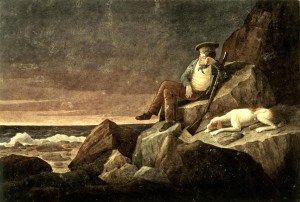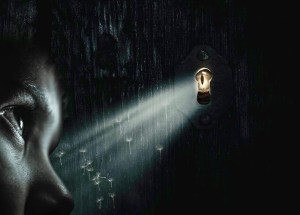We support our Publishers and Content Creators. You can view this story on their website by CLICKING HERE.
Infused with the formative power of story, classic literature—replete with beautiful nature language—has the potential to call us back into the “remembrance of what is,” imparting vital concepts of land and place that will shape the next generation of Creation’s stewards.
Imparting Concepts of Land and Place through Classic Literature
Wendell Berry’s 1964 poem “The Wild” captures the poignant beauty of nature breaking through a world increasingly indifferent to its presence. Offering a stark contrast between a wasted city lot and the colorful flight of warblers and tanagers, Berry calls his reader to embrace the necessary beauty of the wild, receiving as a gift to modern man “its remembrance of what is.” We have never been more in need of such a gift.
Current research reveals startling statistics suggesting disconnection, depression, and a loss of exposure to and experience of the natural world—a series of terms not unrelated. Social media touts community at the expense of in-person relationships. Technological progress spins at a frenetic pace. And a main component of human life we know to combat these ills is strikingly absent for many. Children—and perhaps their parents—have traded the forest for screen time, nature writing for animé, the classics for the latest dystopian sci-fi binge. As a result, we’ve lost even the language to name and notice the natural world.
Losing More Than Language
British author and scholar Robert Macfarlane sounded the alarm on this phenomenon in his 2017 article in The Guardian entitled “Badger or Bulbasaur—have children lost touch with nature?” In his insightful book, Landmarks, Macfarlane notes the loss of nature literacy among children and contemporary society’s seeming indifference, as evidenced by the Oxford Junior Dictionary’s “culling of words concerning nature.” He suggests that “the substitutions made in the dictionary—the natural being displaced by the indoor and virtual—are a small but significant symptom of the simulated life we increasingly live.” In other words, the loss of language is indicative of a loss of experience. Indeed, he is not the first to note the significant connection between language and reality.
Macfarlane’s assertion that “what is lost along with this [nature] literacy is something precious: a kind of word magic, the power that certain terms possess to enchant our relations with nature and place” bears striking resemblance to Augustine’s view of words as signs: “A thing which, over and above the impression it makes on the senses, causes something else to come into the Mind as a consequence of itself.” Augustine argues that “all instruction is either about things or about signs; but things are learnt by means of signs…. No one uses words except as signs of something else.” For both Macfarlane and Augustine, then, language points toward reality—and our current nature illiteracy suggests that we are losing touch with the human experience of land and place.
Signs of Change
But the news isn’t all bad. If, indeed, words are signs, then language has the power to shape our perceptions of reality—including the natural world. While there is no substitution for the human experience of nature, exposure to nature language can point students toward a critical reality. In fact, infused with the formative power of story, classic literature—replete with beautiful nature language—has the potential to call us back into the “remembrance of what is,” imparting vital concepts of land and place that will shape the next generation of Creation’s stewards.
In Book 2 of On Christian Doctrine, Augustine writes that a sign first makes an impression on the senses before we think of something else—
When we see a footprint, we conclude that an animal whose footprint this is has passed by; and when we see smoke, we know that there is fire beneath; and when we hear the voice of a living man, we think of the feeling in his mind; and when the trumpet sounds, soldiers know that they are to advance or retreat, or do whatever else the state of the battle requires.
Often those signs are imprinted upon our minds when we are young. They often precede words and names. Though Macfarlane acknowledges that children don’t need formal names as a guide, he does believe that naming provides an imaginative relationship with the natural world. Classic novels such as Willa Cather’s O Pioneers! offer a deep repository of such language, calling the reader into wonder and engagement with the natural world. Landscapes come alive with her masterful descriptions of foliage and place:
The Bergson wagon lurched along over the rough hummocks and grass banks, followed the bottom of winding draws, or skirted the margin of wide lagoons, where the golden coreopsis grew up out of the clear water and the wild ducks rose with a whirr of wings….
In Crazy Ivar’s country the grass was short and gray, the draws deeper than they were in the Bergson’s neighborhood, and the land was all broken up into hillocks and clay ridges. The wild flowers disappeared, and only in the bottom of the draws and gullies grew a few of the very toughest and hardiest: shoestring, and ironweed, and snow-on-the mountain.
Here Cather gifts the reader with more than mere vocabulary: the rhythms and sounds of the language itself impart a sense of meaning. One can almost feel the lurching over bumpy, two-syllabled “hummocks” and feel the swing of moving, snakelike, through “winding draws.” The hardiness of “ironweed” and “snow-on-the mountain” comes to us through associations with metal and height, and our imaginations begin to grasp, if but a little, Cather’s view of the natural world. Indeed, through fiction, Cather is revealing how her characters, and how we, can see beauty in even the sparse landscape of the plains. Her linguistic landscape is both shaping her characters and shaping us.
Cather writes about that same feature in Sarah Orne Jewett’s works. Jewett was a close friend and fellow author, and Cather praises her nature writing: “The Pointed Firs sketches are living things caught in the open, with light and freedom and air spaces about them. They melt into the land and the life of the land until they are not stories at all, but life itself.” Cather catches the broad romance of Jewett’s tales, but Jewett details the New England ways of water and land well. In “Mrs. Todd,” the greenest of gardens is filled with flowers we may or may not know. Words like “hollyhock” and “London-pride” allude to height, but our curiosity is pricked by the array of herbs and what Mrs. Todd concocts with her medicines and brews:
But the discovery was soon made that Mrs. Todd was an ardent lover of herbs, both wild and tame, and the sea-breezes blew into the low end-window of the house laden with not only sweet-brier and sweet-mary, but balm and sage and borage and mint, wormwood and southernwood. If Mrs. Todd had occasion to step into the far corner of her herb plot, she trod heavily upon thyme, and made its fragrant presence known with all the rest.
Kitchen herbs are commonly known, but “sweet-brier” and “sweet-mary” must be sweet by taste or smell just as “wormwood” and “southernwood” appear stocky, dull, or unsavory. Jewett’s garden catalog illuminates what we may have lost and equally can rediscover through her descriptions of Maine and its botany.
Perennial favorite Wind in the Willows, by Kenneth Grahame, affects its reader in a similar vein: Grahame’s stories burst with bountiful nature language, incorporating sentences and paragraphs which nearly sing the song of the natural world. While any onlooker may notice that the characters themselves are animals found in the forests and waterways, it is Grahame’s masterful descriptions which draw the reader into a secondhand experience of nature. We almost feel the scratching stalks and hear the movement of wheat when Grahame writes of the Water Rat,
Leaving the waterside, where rushes stood thick and tall in a stream that was
becoming sluggish and low, he wandered country-wards, crossed a field or two of
pasturage already looking dusty and parched, and thrust into the great sea of wheat,
yellow, wavy, and murmurous, full of quiet motion and small whisperings. Here he
often loved to wander, through the forest of stiff strong stalks that carried their own
golden sky away over his head—a sky that was always dancing, shimmering, softly
talking; or swaying strongly to the passing wind and recovering itself with a toss and a
merry laugh.
We don’t need to visit a prairie or farmstead in order to catch a view. The reader is instead carried into this experience by Grahame himself, as thick “rushes” and dusty “pasturage” blended with the sounds and motions of the invisible forces of nature begin to signal something new in our minds. Through the stories of the Water Rat, Mole, Toad, and others, the reader is gifted with a sensory experience that leaves him transformed.
In the same vein, L. M. Montgomery describes a fascination with nature in Emily of New Moon. While Emily still lives in Maywood, she tells us she is friends with the Wind Woman, the spruce trees Adam-and-Eve, the Rooster Pine, and all the lady-birches. Her fanciful imagination blooms in the nature that surrounds her.
She loved the spruce barrens, away at the further end of the long, sloping pasture. That was a place where magic was made. She came more fully into her fairy birthright there than in any other place… the brown, frosted grasses under her feet were velvet piles. The old, mossy, gnarled, half-dead spruce tree, under which she paused for a moment to look up into the sky, was a marble column in a palace of the gods; the far, dusky hills were the ramparts of a city of wonder. And for companions she had all the fairies of the countryside… anything might happen there— everything might come true.
Most of the characters in these stories are isolated by family situations and the death of parents, and yet they are able to take notice of what surrounds them. But more than noticing, they truly see the beauty and are inspired.
A Catalyst for Re-Imagination
A decidedly rich era of classic literature, the turn of the 19th century was a boon to the dictionary of nature. Twain, Hawthorne, Cather, Melville, Jewett, and others were masters of their geography and the lands they loved so well. Such mastery bears complex roots: these authors inherited a way of life dependent on planting and sowing, walking and weather patterns. Their knowledge of nature was intimate–almost innate.
While time has changed not only lifestyle but the language which accompanies it, the rivers, islands, prairies, and coastlands so vividly displayed through these stories offer a new generation a unique opportunity to access—and even acquire—what many fear as lost. Through encountering these linguistic signs of natural life, a person may yet be transformed by something more powerful than the forces of technology and the frenetic pace of a contemporary economy—for Cather, Jewett, Grahame, and Montgomery simultaneously point us outward and inward. As we begin to glimpse something of nature’s magic, we come to know something of ourselves as well. As Wendell Berry’s poetry prophesies, we come to a profound “remembrance of what is.”
 Sara Osborne serves as Assistant Professor of English and Director of Classical Education at College of the Ozarks in Point Lookout, MO, and Associate Fellow at The Kirby Laing Centre for Public Theology in Cambridge. She is the author of Reading for the Long Run: Leading Struggling Students into the Reading Life (CiRCE Press, 2023).
Sara Osborne serves as Assistant Professor of English and Director of Classical Education at College of the Ozarks in Point Lookout, MO, and Associate Fellow at The Kirby Laing Centre for Public Theology in Cambridge. She is the author of Reading for the Long Run: Leading Struggling Students into the Reading Life (CiRCE Press, 2023).
The Imaginative Conservative applies the principle of appreciation to the discussion of culture and politics—we approach dialogue with magnanimity rather than with mere civility. Will you help us remain a refreshing oasis in the increasingly contentious arena of modern discourse? Please consider donating now.
The featured image is “Going Home (Pioneers Braving a Storm)” (1878), by William Hahn, and is in the public domain, courtesy of Wikimedia Commons.

 Conservative
Conservative  Search
Search Trending
Trending Current News
Current News 






